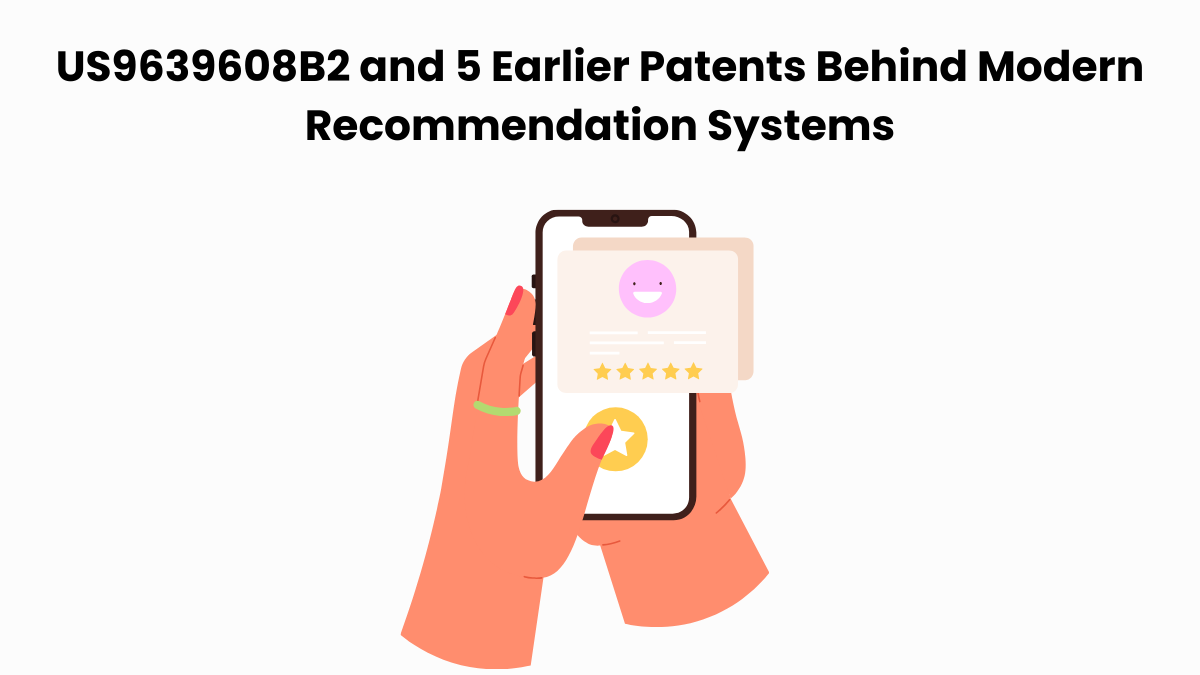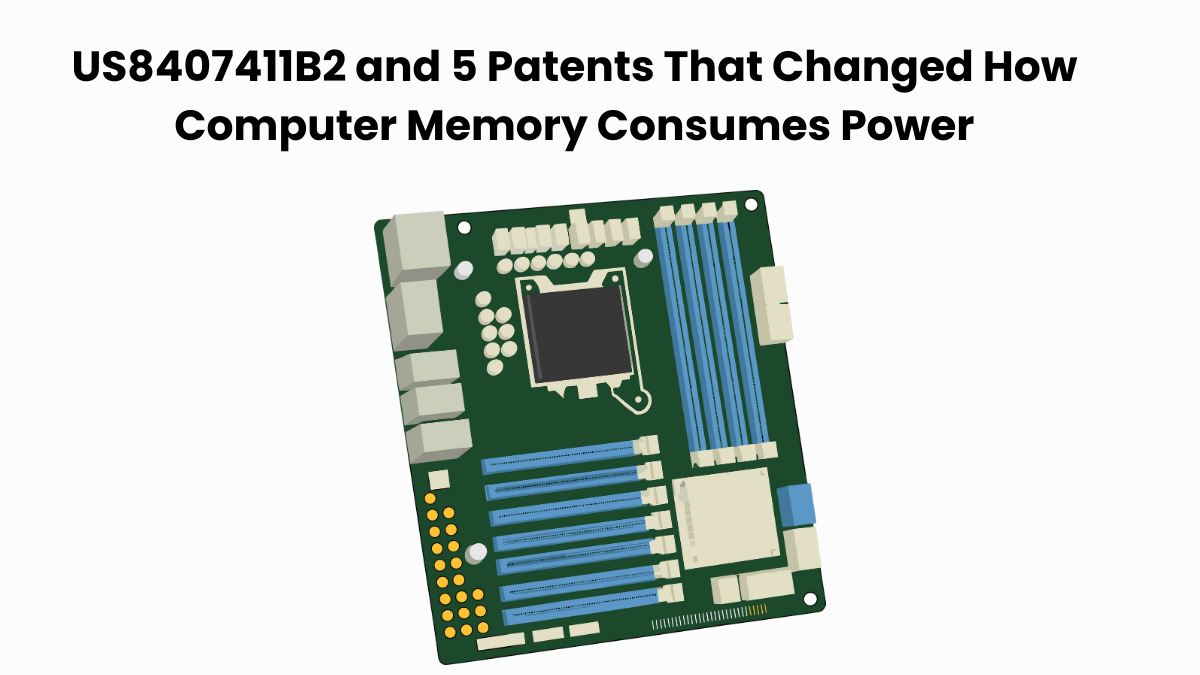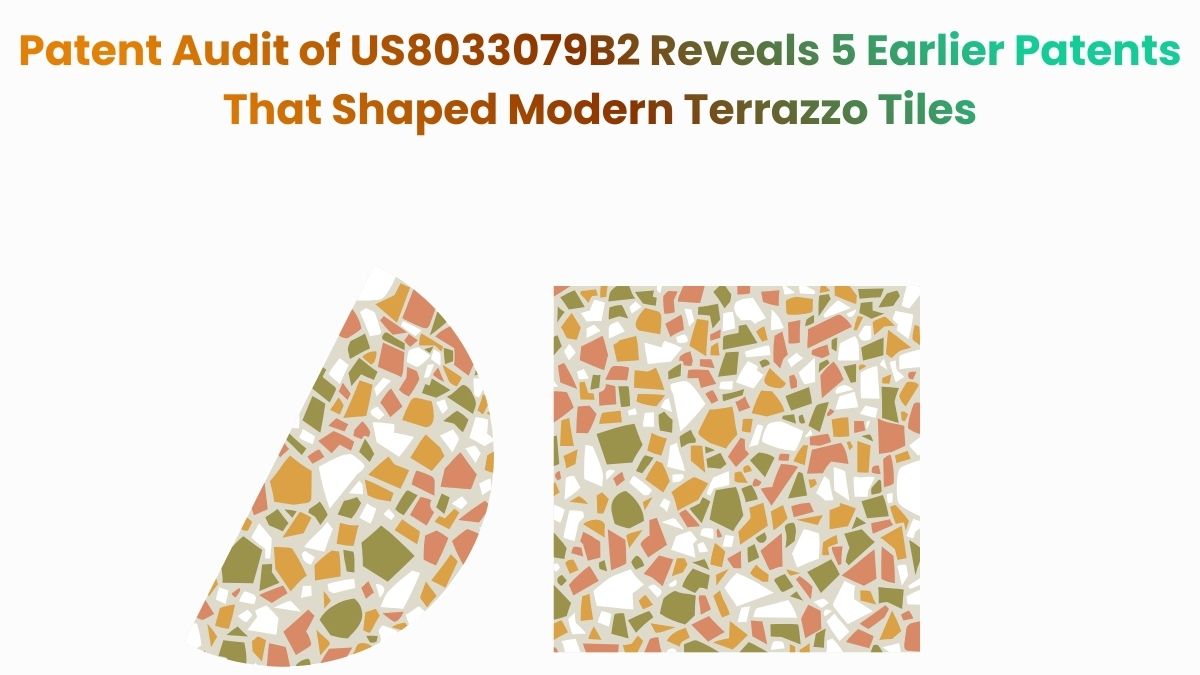Some patents gain attention not for the legal battles they spark, but for the technologies they quietly enable. US10637142B1 fits that description. It appears in the case Fractal Networks LLC v. Urban AI Solutions, though we won’t focus on the litigation.
This patent describes a system with steerable antennas and edge computing designed for low-latency communication with a fixed target. These features are becoming increasingly important as networks demand faster and more focused data delivery. The same demand is reshaping industries like autonomous aviation; see how electric aircraft developers are approaching real-time communications.
In this article, we use the Global Patent Search (GPS) tool to explore related patents with similar structures and communication models. Instead of legal analysis, we focus on the technical overlap between inventions. For IP professionals and tech researchers, this is a data-driven examination of the innovation behind US10637142B1.
Understanding Patent US10637142B1
US10637142B1, titled “Computing System,” introduces a low-latency communication framework designed for precision-targeted edge computing. The system integrates a transceiver, steerable antennas, and a local processing unit. These edge modules reflect broader trends across the smart device ecosystem, as highlighted in our overview of leading Edge AI companies.
These components work together to maintain a high-speed, directional link with a specific target device or endpoint. The edge processor offloads tasks from cloud-based systems, reducing delay and bandwidth strain. This design supports high-demand environments like 5G networks, smart cities, and autonomous devices.
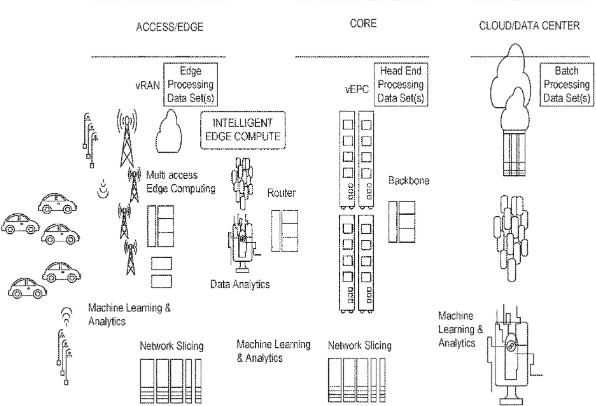
Source: Google Patents
Its Four Key Features Are
#1. Transceiver with steerable antennas: A transceiver communicates with a fixed target using one or more antennas that are mechanically or electrically adjustable.
#2. Edge computing module: A local processor, often housed with the antenna, handles data processing near the source to reduce latency.
#3. Beam sweeping and traffic optimization: The system adjusts beam direction based on network history, traffic demand, or service-level agreements.
#4. Integration with AI and learning models: Neural networks or learning machines help calibrate the antenna and manage communication quality in real time.
This technology supports emerging needs in smart infrastructure, low-latency edge computing, and real-time communication. Its architecture aligns with advanced 5G and AI-enabled network systems.
Did you know? Real-time imaging depends on both processing speed and optical response. Inside VDPP LLC’s Litigation Strategy: US9699444B2 and Its Related Patents covers lens systems that sync video motion with fast-switching 3D visualization.
Similar Patents As US10637142B1
To explore the innovation landscape surrounding US10637142B1, we ran the patent through the Global Patent Search tool. Below is a quick glimpse of the GPS tool in action:
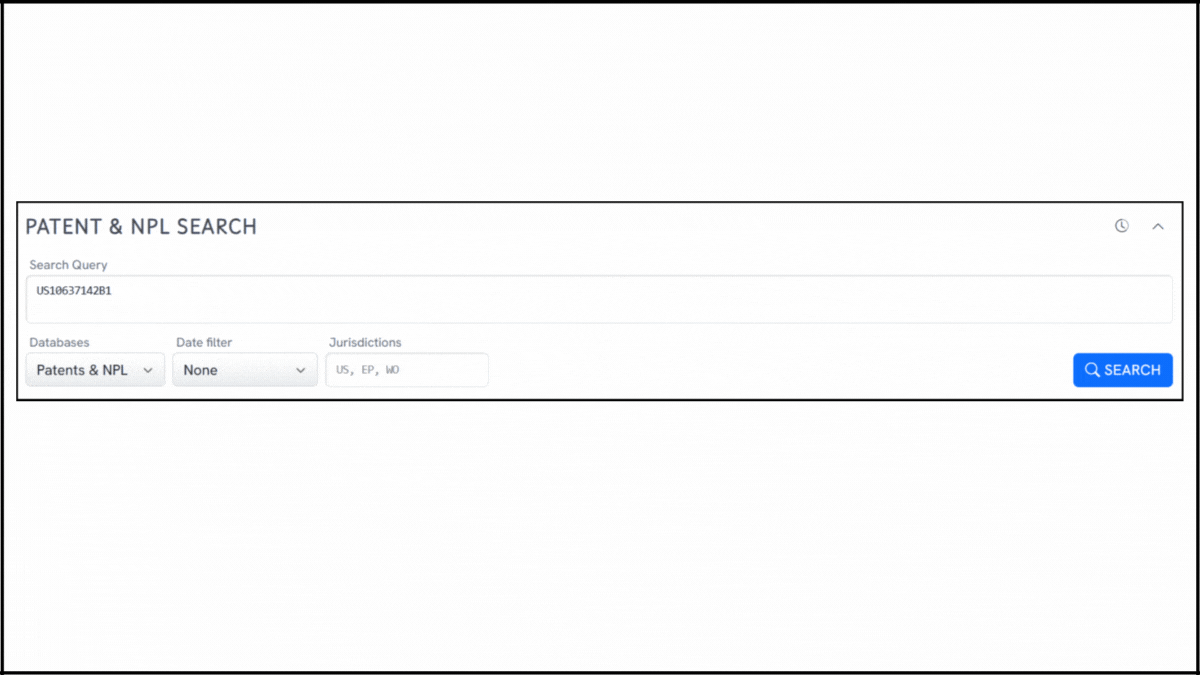
Source: Global Patent Search
This analysis surfaced a list of related patents that share technical similarities in edge-based computation, antenna control, and network optimization. Below, we highlight five of these references that reflect comparable ideas in intelligent wireless systems. These examples offer insight into how similar challenges have been addressed across different communication technologies.
#1. CN103945398B
This Chinese patent, CN103945398B, published in July 2017, focuses on using a fuzzy neural network to optimize base station antenna elevation and transmit power. It introduces a distributed, self-organizing module that dynamically adjusts network parameters based on real-time performance feedback.
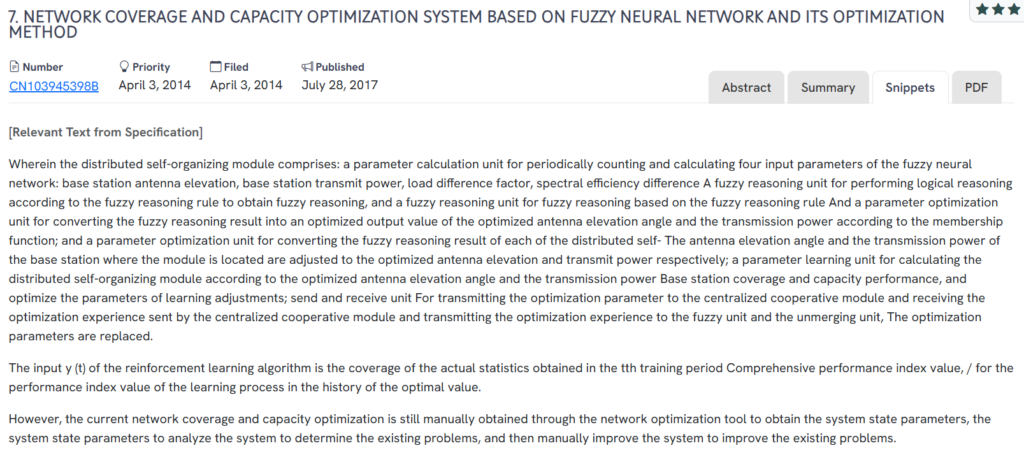
Source: GPS
What This Patent Introduces To The Landscape
- Distributed optimization module – Automates antenna and power adjustments using fuzzy logic and local performance inputs.
- Real-time parameter tuning – Tracks four critical parameters: elevation, transmit power, load difference, and spectral efficiency.
- Fuzzy reasoning engine – Uses predefined rules to convert network conditions into optimized elevation and power outputs.
- Reinforcement learning integration – Continuously improves optimization accuracy based on prior training results and live coverage data.
- Decentralized control logic – Enables each base station to operate independently while sharing learning outcomes with centralized modules.
How It Connects To US10637142B1
- Both patents use AI techniques to dynamically control antenna direction and behavior.
- Each system relies on local computation to reduce latency and improve signal precision.
- Both designs aim to enhance performance through real-time environmental feedback and optimization logic.
Why This Matters
This patent shows how learning-based optimization improves antenna efficiency across changing network conditions. Its distributed control and adaptive response mirror the intelligent antenna and edge processing goals found in US10637142B1.
#2. GB2551124A
This British patent, GB2551124A, published in December 2017, focuses on applying Q-learning algorithms to optimize user equipment (UE) association in dynamic 5G environments. The invention explores machine learning-based approaches to adaptively configure network connections based on throughput, location, and signal quality.
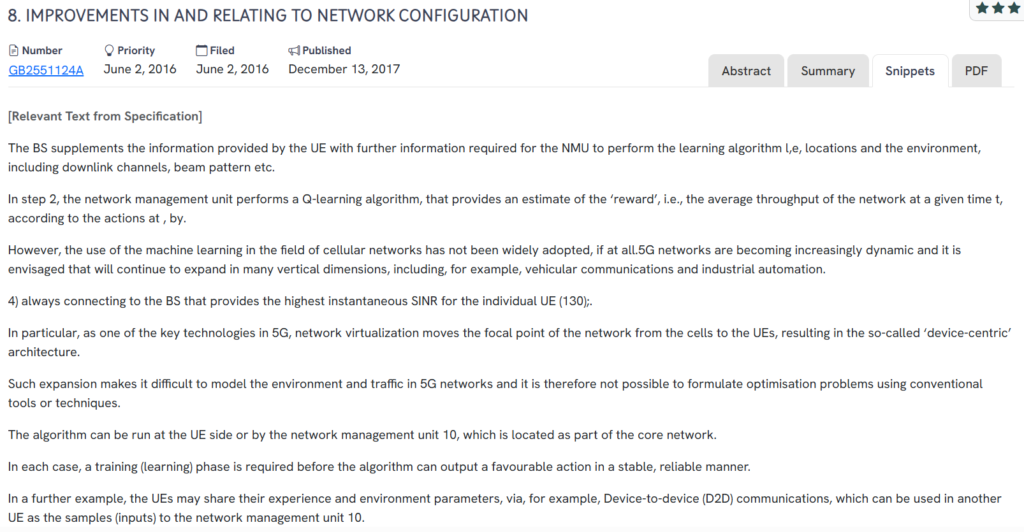
Source: GPS
What This Patent Introduces To The Landscape
- Q-learning for network configuration – Uses reinforcement learning to estimate optimal actions that improve average network throughput in real time.
- Device-centric architecture – Shifts control from fixed base stations to individual UEs for flexible network adaptation.
- Experience sharing via D2D – Enables UEs to exchange environment and performance data to improve collective learning outcomes.
- Dynamic UE association – Selects the best base station connection based on current SINR and environmental conditions.
- Distributed algorithm deployment – Allows learning models to run at either the UE or core network, depending on system design.
How It Connects To US10637142B1
- Both systems use machine learning to adapt network behavior in real time.
- Each design supports distributed decision-making to manage signal paths and optimize connectivity.
- Both target low-latency, high-throughput performance in complex, evolving 5G ecosystems.
Why This Matters
This patent highlights early efforts to apply learning models within cellular network infrastructure. Its use of real-time feedback, distributed control, and adaptive UE behavior aligns closely with the intelligent edge and antenna strategies described in US10637142B1.
#3. CN109874154B
This Chinese patent, CN109874154B, published in May 2023, focuses on user association and computing resource allocation in C-RAN systems using deep reinforcement learning. It aims to minimize service delays and improve network efficiency through centralized decision-making.
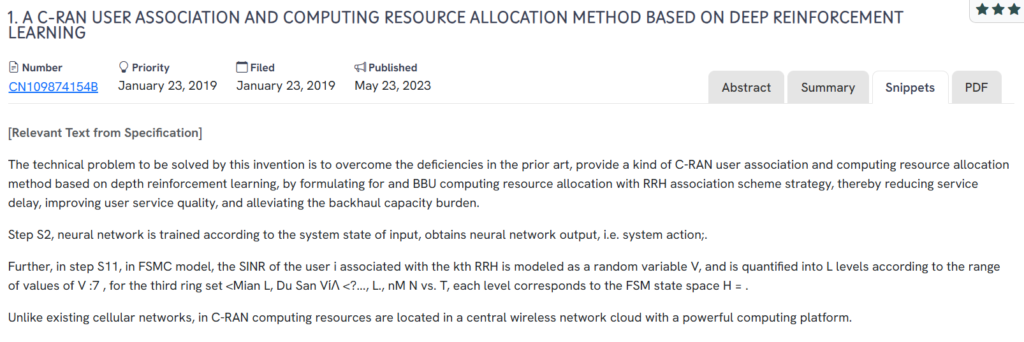
Source: GPS
What This Patent Introduces To The Landscape
- C-RAN user association strategy – Pairs user devices with remote radio heads (RRHs) based on channel conditions and service demand.
- Deep reinforcement learning model – Trains a neural network to determine the best system action from a given network state.
- Centralized computing control – Uses a baseband unit (BBU) pool to manage cloud-based resources across multiple network nodes.
- SINR-based state modeling – Represents user signal quality as finite state space levels for better learning accuracy.
- Backhaul optimization – Reduces traffic congestion between RRHs and the central cloud by efficiently allocating computing loads.
How It Connects To US10637142B1
- Both systems rely on AI models to manage signal routing and optimize latency-sensitive processes.
- Each method uses network state data (e.g., SINR) to adjust resource allocation.
- Both aim to enhance real-time communication by striking a balance between edge behavior and centralized intelligence.
Why This Matters
This patent reflects how cloud-RAN architectures integrate learning-based decision-making to reduce delay and enhance throughput. Its alignment with neural-driven optimization mirrors the edge-based, AI-enhanced communication model proposed in US10637142B1.
#4. US20200314826A1
This U.S. patent application, US20200314826A1, published in October 2020, focuses on adaptive beam sweeping for 5G and next-generation networks using AI-driven control systems. It introduces a modular framework that predicts UE distribution and dynamically adjusts beam directions based on real-time and historical data.
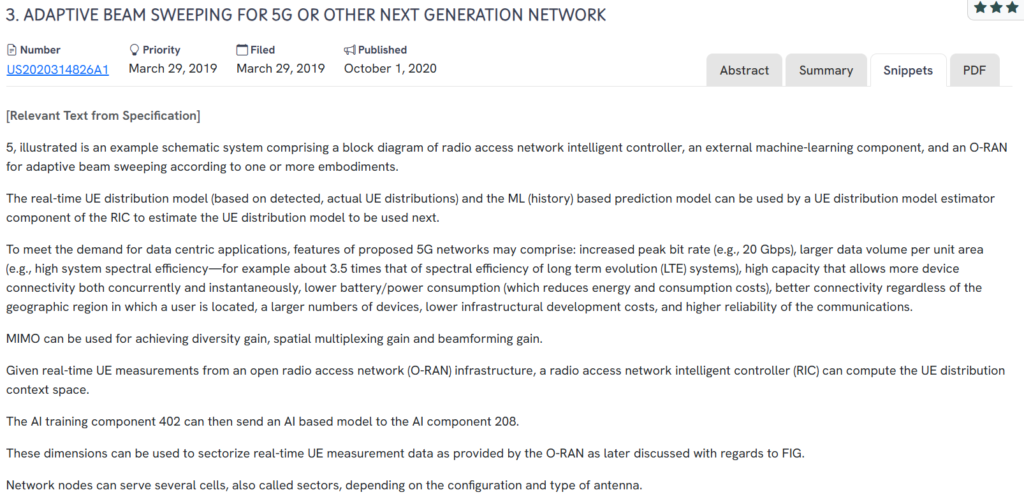
Source: GPS
What This Patent Introduces To The Landscape
- AI-assisted beam sweeping – Uses real-time and historical UE data to adjust beam directions across sectors intelligently.
- O-RAN architecture with RIC – Implements a radio access network intelligent controller (RIC) to manage UE contexts and signal routing.
- UE distribution prediction – Combines live UE data with learned movement patterns to forecast where signals should be directed next.
- Integration of SDN and MIMO – Leverages software-defined networking and massive MIMO to boost capacity, coverage, and flexibility.
- AI model distribution framework – Enables external AI modules to train and distribute optimization models into the RAN environment.
How It Connects To US10637142B1
- Both patents use machine learning to improve antenna directionality in response to real-time UE data.
- Each relies on adaptive beamforming techniques to maintain optimal signal paths.
- Both support distributed, intelligent decision-making using modular AI components.
Why This Matters
This patent demonstrates how adaptive beam sweeping can be enhanced with AI and open networking frameworks. Its use of intelligent signal prediction closely parallels the edge-based, learning-driven antenna control described in US10637142B1.
#5. CN111050330A
This Chinese patent application, CN111050330A, published in April 2020, presents a self-optimization method for mobile networks using reinforcement learning. It focuses on real-time network tuning, including antenna downtilt and load balancing, guided by trained AI models.
Source: GPS
What This Patent Introduces To The Landscape
- Reinforcement learning model – Uses deterministic strategy gradients to optimize network actions in real time.
- Adaptive downtilt control – Adjusts antenna angles within a limited range (0–15°) for precise coverage tuning.
- Environment-driven strategy – Inputs real-world environmental state observations into the trained model to derive configuration actions.
- Load-aware cell balancing – Distributes traffic by analyzing load indicators across nearby cells.
- Integrated policy deployment – Issues control instructions directly to cells to implement strategy-based reconfiguration.
How It Connects To US10637142B1
- Both systems use real-time data and learning models to adjust antenna configurations.
- Each supports self-optimizing behavior without relying on manual tuning.
- Both emphasize precise, low-latency performance in dynamic wireless environments.
Why This Matters
This patent highlights the importance of fine-grained, AI-guided control in managing mobile network performance. Its emphasis on coverage, load, and latency aligns closely with the intelligent edge processing and steerable antenna design in US10637142B1.
Similar intelligent infrastructure optimization is also reshaping energy networks. Explore the evolution of smart grid technology driven by adaptive AI systems.
How To Find Related Patents Using Global Patent Search
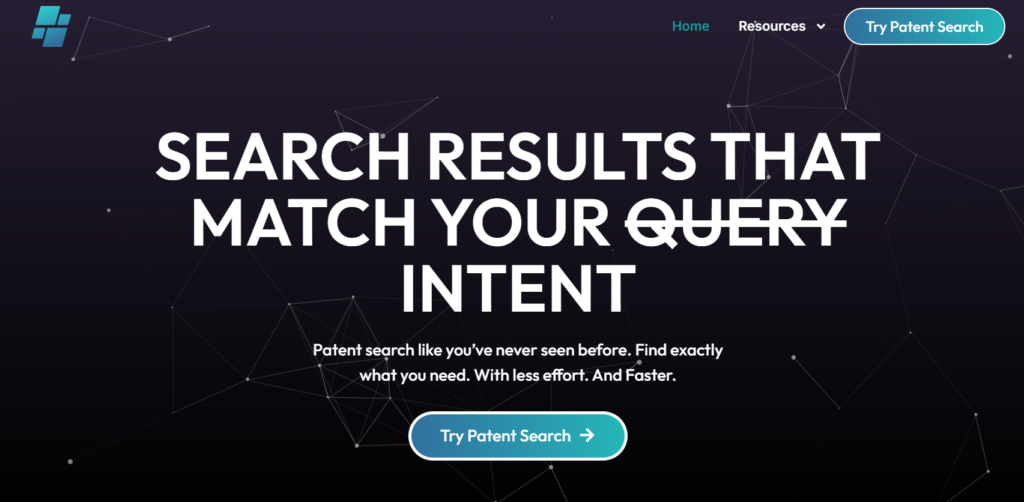
Understanding the broader innovation landscape surrounding edge-enabled antenna systems is critical for optimizing 5G infrastructure, enhancing beam steering, and advancing low-latency processing. The Global Patent Search tool streamlines this process, helping users uncover inventions that share architectural principles or adaptive signal strategies. Here’s how it works:
1. Enter the patent number into GPS: Type in a patent number like US10637142B1. GPS converts it into an intelligent query, which can be refined using antenna terms, AI keywords, or edge-computing functions.

2. Explore conceptual snippets: Instead of mapping claims line-by-line, GPS now returns targeted text snippets. These highlight functional overlaps, showing how other patents approach beam control, antenna tuning, or local signal processing.

3. Identify related inventions: The tool surfaces systems with similar design intent, like intelligent antenna steering, ML-guided optimization, or modular processing, which helps trace technological parallels more clearly.
4. Compare systems, not legal claims: GPS centers the analysis on system behavior and architectural logic. This allows engineers and analysts to evaluate practical similarities without having to parse through legal claim language.
5. Accelerate cross-domain insights: Whether you’re working on telecom networks, autonomous vehicles, or industrial IoT, GPS reveals patent activity that could otherwise go unnoticed, fostering broader awareness and faster iteration.
With this concept-based approach, Global Patent Search supports more strategic R&D decisions and enables smarter evaluation of surrounding technologies.
Disclaimer: The information provided in this article is for informational purposes only and should not be considered legal advice. The related patent references mentioned are preliminary results from the Global Patent Search tool and do not guarantee legal significance. For a comprehensive related patent analysis, we recommend conducting a detailed search using GPS or consulting a patent attorney.


